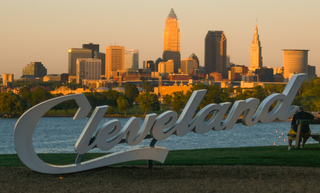
Cleveland, officially the City of Cleveland, is a city in the U.S. state of Ohio and the county seat of Cuyahoga County. Located in Northeast Ohio along the southern shore of Lake Erie, it is situated across the U.S. maritime border with Canada and lies approximately 60 miles (97 km) west of Pennsylvania.
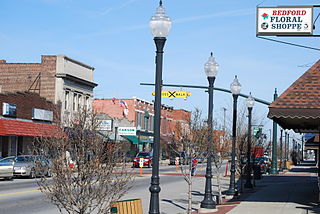
Bedford is a city in Cuyahoga County, Ohio, United States located to the east of Cleveland. The population was 13,149 at the 2020 census. It is an eastern first ring suburb of Cleveland.

Lakewood is a city in Cuyahoga County, Ohio, United States, on the southern shore of Lake Erie. Established in 1889, it is one of Cleveland's historical streetcar suburbs and part of the Cleveland metropolitan area. The population was 50,942 at the 2020 census, making it the third largest city in Cuyahoga County, behind Cleveland and Parma.

Baldwin Wallace University (BW) is a private university in Berea, Ohio. Established in 1845 as Baldwin Institute by Methodist businessman John Baldwin, it merged with nearby German Wallace College in 1913 to become Baldwin-Wallace College.

University Circle is a district in the neighborhood of University on the East Side of Cleveland, Ohio. It is home to the Cleveland Museum of Art, Severance Hall, the Cleveland Institute of Art, Case Western Reserve University, the Cleveland Institute of Music, the Museum of Contemporary Art Cleveland; the Cleveland Botanical Garden; historic Lake View Cemetery; the Cleveland Museum of Natural History; and University Hospitals/Case Medical Center.

Karamu House in the Fairfax neighborhood on the east side of Cleveland, Ohio, United States, is the oldest African-American theater in the United States opening in 1915. Many of Langston Hughes's plays were developed and premièred at the theater.

Playhouse Square is a theater district in downtown Cleveland, Ohio, United States. It is the largest performing arts center in the US outside of New York City. Constructed in a span of 19 months in the early 1920s, the theaters became a major entertainment hub for the city for much of the 20th century. However, by the late 1960s, the district had fallen into decline and its theaters had closed down. In the 1970s, the district was revived through a grassroots effort that helped usher in a new era of downtown revitalization. For this reason, the revival of Playhouse Square is often locally referred to as being "one of the top ten successes in Cleveland history."

Broadway–Slavic Village is a neighborhood on the Southeast side of Cleveland, Ohio. One of the city's oldest neighborhoods, it originated as the township of Newburgh, first settled in 1799. Much of the area has historically served as home to Cleveland's original Czech and Polish immigrants. While demographics have shifted over the decades, the largest part of Broadway today, Slavic Village, is named for these earlier communities.

Public Square is the central plaza of Downtown Cleveland, Ohio. Based on an 18th-century New England model, it was part of the original 1796 town plat overseen by city founder General Moses Cleaveland of the Connecticut Land Company. The historical center of the city's downtown, it was added to the National Register of Historic Places in 1975.

This is a list of the National Register of Historic Places listings in Cleveland, Ohio.
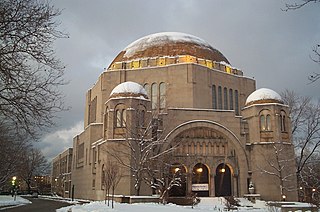
Milton and Tamar Maltz Performing Arts Center at Temple–Tifereth Israel is a 1200-seat historic arts and religious venue on the campus of Case Western Reserve University located on the Hough and University Circle border at Silver Park in Cleveland, Ohio.

The Plaza Apartments is a historic five-story apartment building located in the Central neighborhood of Cleveland, Ohio, United States. Built in 1901, it was designed by the architectural firm of Steffens, Searles & Hirsh, which built many middle-class apartment buildings in the Cleveland era around the turn of the twentieth century. It features a primarily brick facade; stone appears in the exterior, and the foundation is stone. It was added to the National Register of Historic Places on November 1, 1984, being included primarily for its architectural significance. Other historic buildings surround the Plaza Apartments: it was added to the Register as part of the "Upper Prospect Multiple Resource Area," and the Register-listed Jeremiah Ensworth House is located next door. Located just a quarter of a mile (400 m) from the Cleveland State University campus, the Plaza Apartments remains an active apartment building today, although named the "Plaza Suites."
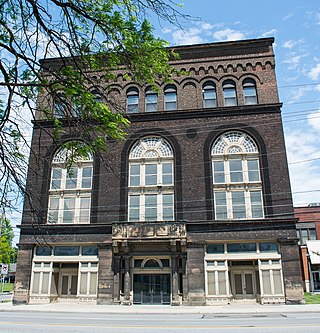
Bohemian National Hall is an historic building located in the Broadway–Slavic Village neighborhood of Cleveland, Ohio. It was listed on the National Register of Historic Places in May 1975. The hall was built to serve the cultural and educational needs of the city's Czech community, and currently serves as host to Sokol Greater Cleveland and the Cleveland Czech Cultural Center and Museum.

The history of Baldwin Wallace University dates back to 1828, when co-founder John Baldwin settled in present-day Berea, Ohio. His founding eventually established Baldwin–Wallace College. This founding of present-day Baldwin Wallace University began when Baldwin Institute was established in 1845. With the help of James Wallace, Baldwin Institute began offering college courses. Eventually, in 1863, a resolution established a separate school from Baldwin University to serve the booming local German population called German Wallace College. Originally part of Baldwin Institute, German Wallace College was established just down the road. As a result of financial hardships the schools merged in 1913, forming Baldwin-Wallace College. In 2010, several buildings were added to the National Register of Historic Places combining the former Lyceum Village Square and German Wallace College to form the BW South Campus Historic District. In 2012, Baldwin-Wallace College became Baldwin Wallace University and established the BW North Campus Historic District. The Conservatory is home to the Baldwin-Wallace Bach Festival, the oldest collegiate Bach Festival and the second-oldest Bach festival in the United States honoring Johann Sebastian Bach.

Hubbell & Benes was a prominent Cleveland, Ohio architectural firm formed by Benjamin Hubbell (1857–1935) and W. Dominick Benes (1867–1953) in 1897 after the pair departed from Coburn, Barnum, Benes & Hubbell. Their work included commercial and residential buildings as well as telephone exchange buildings, the West Side Market and Cleveland Museum of Art. Before teaming up, they worked for Coburn and Barnum. Benes was Jeptha Wade’s personal architect and designed numerous public buildings, commercial buildings, and residences for him including the Wade Memorial Chapel.
Robert Andrews Little (1919–2005) was a modernist architect based in Cleveland, Ohio. He received the Cleveland Arts Prize for Architecture in 1965. Little practiced in the Bauhaus and International styles. He also designed and advocated energy-efficient features, and employed Jewish and African-American architects and engineers.

The Cleveland Trust Company Building is a 1907 building designed by George B. Post and located at the intersection of East 9th Street and Euclid Avenue in downtown Cleveland's Nine-Twelve District. The building is a mix of Beaux-Arts, Neoclassical, and Renaissance Revival architectural styles. It features a glass-enclosed rotunda, a tympanum sculpture, and interior murals.

The Broadway Avenue Historic District is a historic commercial district in the Broadway–Slavic Village neighborhood of Cleveland, Ohio, in the United States. The commercial district is the historic center of Cleveland's Czech community, and is an excellent example of a district that grew along a streetcar line. The historic district includes 43 buildings constructed between 1888 and 1930, including the Hruby Conservatory of Music and Our Lady of Lourdes Church and School. The commercial district was added to the National Register of Historic Places on October 19, 1988.
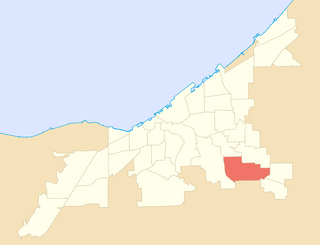
Union–Miles Park is a neighborhood on the Southeast side of Cleveland, Ohio, in the United States. The neighborhood draws its name from Union Avenue, and Miles Park in its far southwest corner.



















